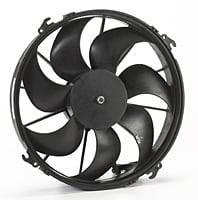The question of how to provide the best cooling for industrial applications has been around since the earliest days of the industrial revolution. When equipment is functioning at a high level, it often produces heat that needs to be dissipated, and today, facilities are using systems that are more advanced than ever.
With the advances in technology that are so commonplace in today’s industrial landscape, many systems are being designed to provide the greatest power possible in the smallest possible space. These systems can run the risk of overheating if they are not designed with an appropriate cooling mechanism.
Overheated equipment can pose many risks, including poor performance of equipment, early component and lubricant deterioration, overall system malfunction, and ultimately the possibility of fire and other safety risks for users and operating personnel.
 In order to avoid these problems, design engineers need to select the appropriate cooling unit for these systems. One popular and economical option is the use of cooling fans. Cooling fans are available in a wide array of options according to the temperature needs of the project. Some considerations that a designer needs to think about when choosing the best cooling application include the size of the unit, voltage, and how much noise is involved.
In order to avoid these problems, design engineers need to select the appropriate cooling unit for these systems. One popular and economical option is the use of cooling fans. Cooling fans are available in a wide array of options according to the temperature needs of the project. Some considerations that a designer needs to think about when choosing the best cooling application include the size of the unit, voltage, and how much noise is involved.
Different Sizes for Different Applications
Just as mechanical systems can come in all different sizes, the dimensions of cooling fans also vary greatly in order to ensure the best temperature stability. This process is usually begun by thermal analysis, which is used to ascertain how much heat is generated inside systems in order to find out how much cooling is necessary.
After this has been determined, a design engineer can then choose the proper sized cooling unit. The exact size needed can be determined according to the sizing and density of the individual application. For instance, cooling units for computers often need to be placed in very small spaces, and therefore will need to be designed to run at a high speed.
By calculating the space available and how much cooling is needed, the appropriate fan can be chosen or designed as needed. Knowing the desired temperature is also necessary for choosing a fan for large scale applications. Larger fans can be used in applications such as locomotive engines that need a large volume of air constantly blowing to keep the engine and engine fluids cool.
Fans of this size are not only used to keep equipment cool, but also to maintain comfortable temperatures for personnel working in industrial environments. Cooling fans for HVAC systems can ensure that all workers are safe and comfortable, and usually are required on a large scale.
High or Low Voltage
 The power supply used for a fan will influence its size and many other aspects of its operation, and must be taken into consideration when choosing the best cooling system. The voltage that a fan requires will be dependent on its size and speed. The parameters that best represent the voltage needed can be found in a fan performance curve.
The power supply used for a fan will influence its size and many other aspects of its operation, and must be taken into consideration when choosing the best cooling system. The voltage that a fan requires will be dependent on its size and speed. The parameters that best represent the voltage needed can be found in a fan performance curve.
A performance curve graphically represents a variety of parameters that relate to the construction of fans. These include the fan space, static pressure, airflow quantity variation, and required current for any specific fan voltage. This tool is essential for design engineers to pick fans that have the correct voltage to cool systems sufficiently.
Certain models, such as DC fans, are built directly proportionate to voltage, making them highly efficient in regard to energy consumption. These models can also be designed with circuits that reduce voltage spikes in operation, providing efficient and smooth cooling results.
Noise
There are many different factors that can influence the noise level associated with fan operation. The amount of noise that comes from a fan is determined in part by how big the fan is and how fast it spins. Essentially, the faster a fan operates the more noise it produces.
A larger fan running at lower speeds can produce the same energy with less noise than a smaller fan running at a high speed. However, these types of size adjustments are not always practical, depending on the size requirements of the design engineer’s specific application. The type of fan employed also affects the amount of noise generated. The two primary types of industrial fans are axial and centrifugal, and they vary when it comes to noise.
Axial fans work similarly to an airplane propeller, and while they tend to be compact, inexpensive, and light, they are noisier than centrifugal fans. When noise is a concern, alterations can be made to fans, and these include insulation of the duct, installing material that dampens sound, or mounting the fan using soft materials such as rubber.
Some noise will be inevitable when operating fans, but certain fan types, installation options, and designs can minimize noise as much as possible.
Many Determining Factors
For buyers and designers in the market for cooling systems, the above factors represent some of the major concerns associated with acquiring fans. There are other aspects to consider as well. The exact sources of heat, fan performance, reliability, and cost all need to be taken into account.
When determined early in the system design process, the correct cooling system will help keep hardware and personnel safe while increasing the longevity of important equipment. By acquiring high quality cooling fans, buyers and designers can easily ensure that even the most advanced, dense, and heat generating equipment can be operated with the utmost safety and efficiency.





